University Financial Accounting Report: Toll Holdings Limited Analysis
VerifiedAdded on 2020/05/16
|11
|2673
|81
Report
AI Summary
This report provides a detailed analysis of Toll Holdings Limited's financial accounting practices, focusing on impairment testing and lease accounting. The report examines the company's approach to goodwill impairment, including the steps taken, assumptions made, and the impact on financial statements. It also explores the company's handling of impairment expenditures and the subjectivity involved in the testing process. Furthermore, the report delves into the fair value measurement and the accounting treatment of operating and capital leases, comparing the previous and current lease regulations. It highlights the impact of lease accounting standards on financial reporting, particularly for airline companies, and discusses the criticisms and benefits of the new lease accounting standard. The analysis aims to provide insights into how companies conduct impairment testing and the implications of lease accounting on financial statement transparency and investor understanding.
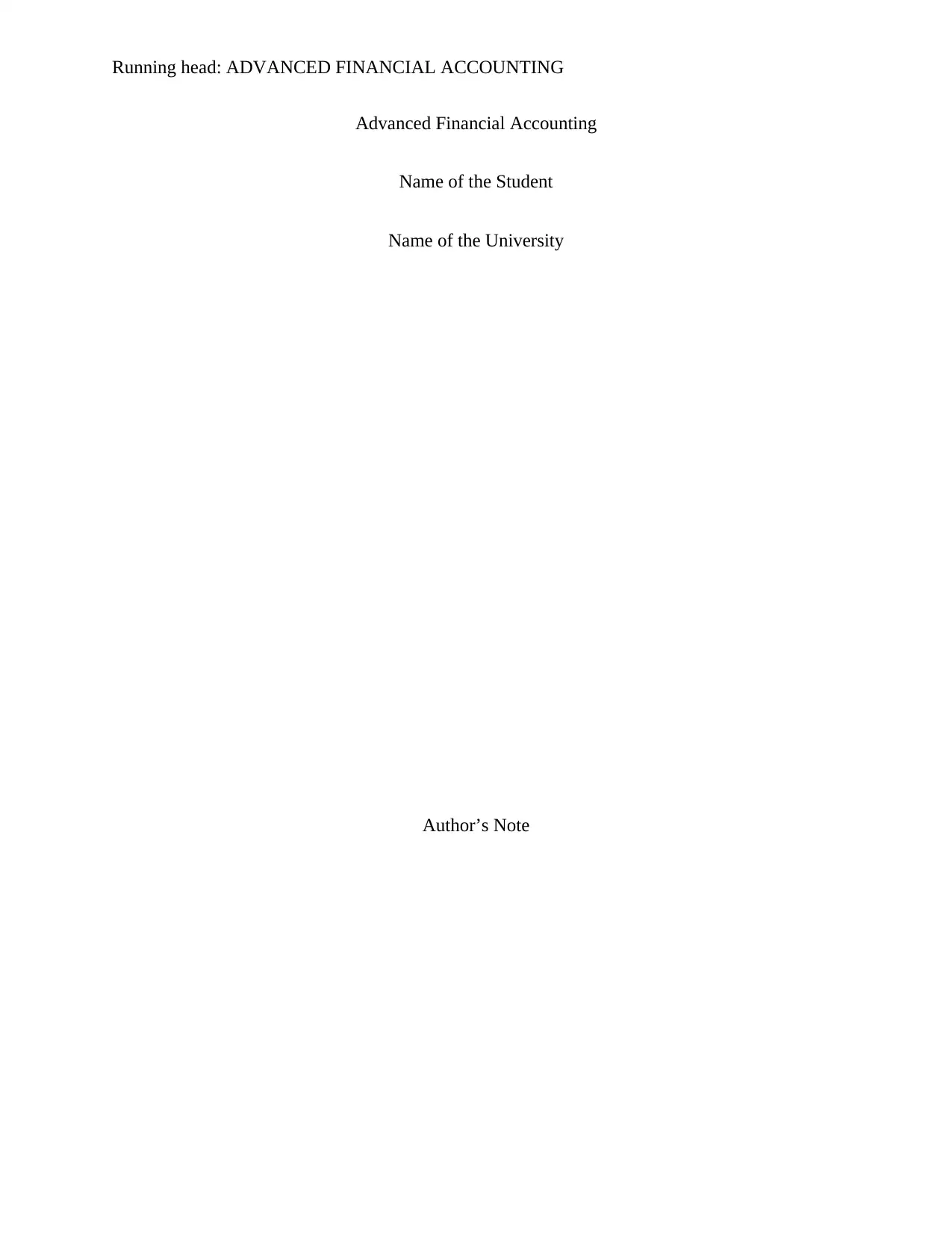
Running head: ADVANCED FINANCIAL ACCOUNTING
Advanced Financial Accounting
Name of the Student
Name of the University
Author’s Note
Advanced Financial Accounting
Name of the Student
Name of the University
Author’s Note
Paraphrase This Document
Need a fresh take? Get an instant paraphrase of this document with our AI Paraphraser
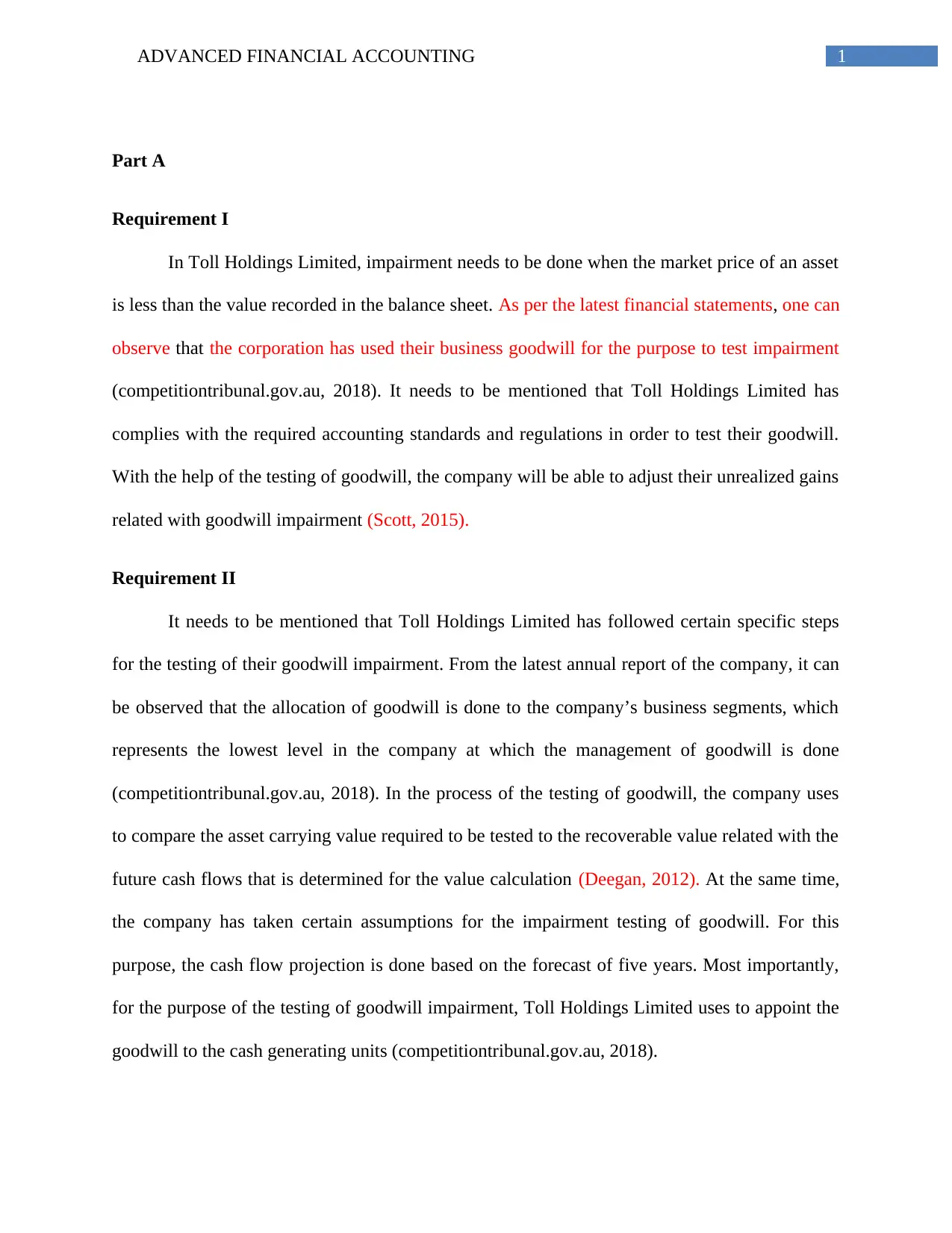
1ADVANCED FINANCIAL ACCOUNTING
Part A
Requirement I
In Toll Holdings Limited, impairment needs to be done when the market price of an asset
is less than the value recorded in the balance sheet. As per the latest financial statements, one can
observe that the corporation has used their business goodwill for the purpose to test impairment
(competitiontribunal.gov.au, 2018). It needs to be mentioned that Toll Holdings Limited has
complies with the required accounting standards and regulations in order to test their goodwill.
With the help of the testing of goodwill, the company will be able to adjust their unrealized gains
related with goodwill impairment (Scott, 2015).
Requirement II
It needs to be mentioned that Toll Holdings Limited has followed certain specific steps
for the testing of their goodwill impairment. From the latest annual report of the company, it can
be observed that the allocation of goodwill is done to the company’s business segments, which
represents the lowest level in the company at which the management of goodwill is done
(competitiontribunal.gov.au, 2018). In the process of the testing of goodwill, the company uses
to compare the asset carrying value required to be tested to the recoverable value related with the
future cash flows that is determined for the value calculation (Deegan, 2012). At the same time,
the company has taken certain assumptions for the impairment testing of goodwill. For this
purpose, the cash flow projection is done based on the forecast of five years. Most importantly,
for the purpose of the testing of goodwill impairment, Toll Holdings Limited uses to appoint the
goodwill to the cash generating units (competitiontribunal.gov.au, 2018).
Part A
Requirement I
In Toll Holdings Limited, impairment needs to be done when the market price of an asset
is less than the value recorded in the balance sheet. As per the latest financial statements, one can
observe that the corporation has used their business goodwill for the purpose to test impairment
(competitiontribunal.gov.au, 2018). It needs to be mentioned that Toll Holdings Limited has
complies with the required accounting standards and regulations in order to test their goodwill.
With the help of the testing of goodwill, the company will be able to adjust their unrealized gains
related with goodwill impairment (Scott, 2015).
Requirement II
It needs to be mentioned that Toll Holdings Limited has followed certain specific steps
for the testing of their goodwill impairment. From the latest annual report of the company, it can
be observed that the allocation of goodwill is done to the company’s business segments, which
represents the lowest level in the company at which the management of goodwill is done
(competitiontribunal.gov.au, 2018). In the process of the testing of goodwill, the company uses
to compare the asset carrying value required to be tested to the recoverable value related with the
future cash flows that is determined for the value calculation (Deegan, 2012). At the same time,
the company has taken certain assumptions for the impairment testing of goodwill. For this
purpose, the cash flow projection is done based on the forecast of five years. Most importantly,
for the purpose of the testing of goodwill impairment, Toll Holdings Limited uses to appoint the
goodwill to the cash generating units (competitiontribunal.gov.au, 2018).
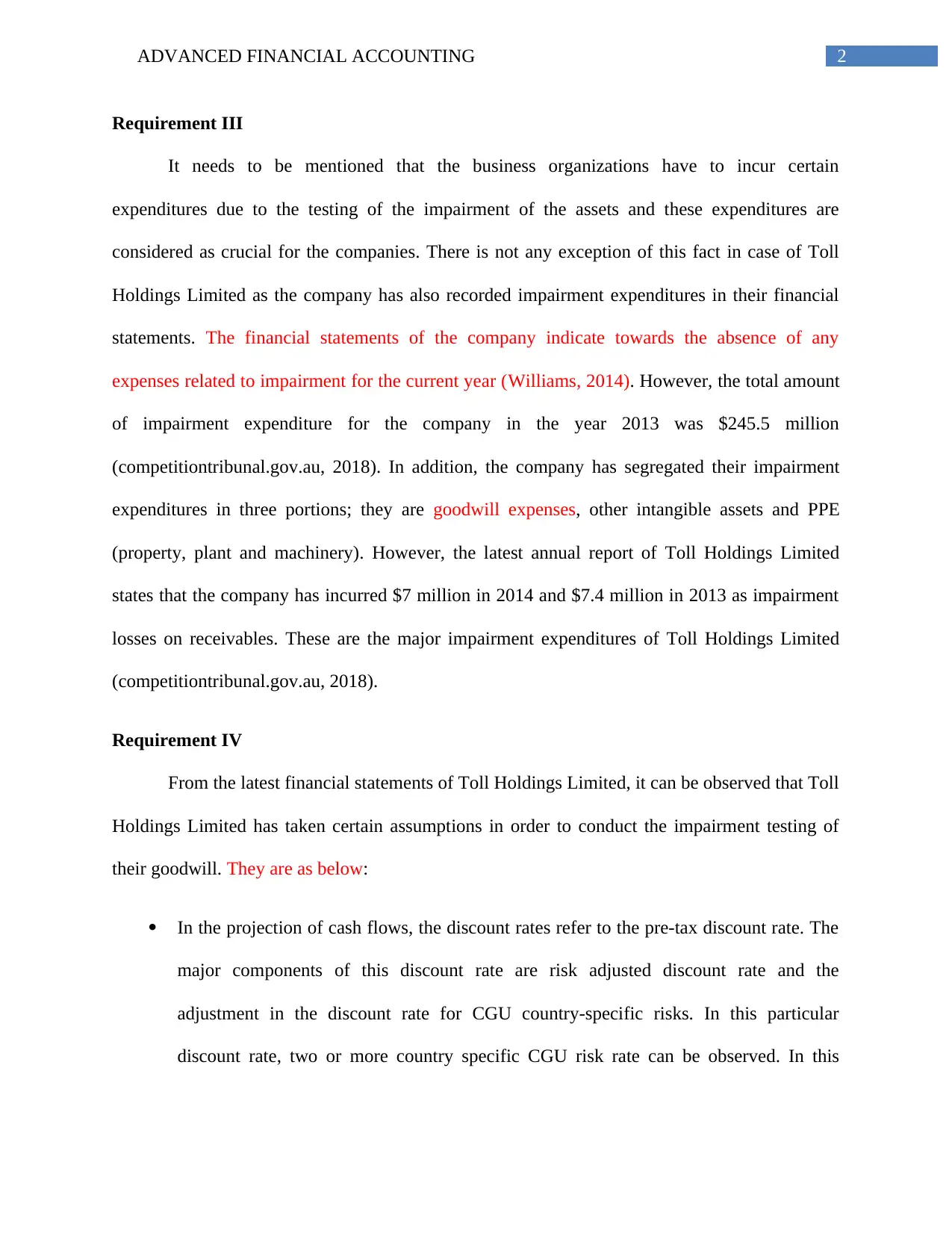
2ADVANCED FINANCIAL ACCOUNTING
Requirement III
It needs to be mentioned that the business organizations have to incur certain
expenditures due to the testing of the impairment of the assets and these expenditures are
considered as crucial for the companies. There is not any exception of this fact in case of Toll
Holdings Limited as the company has also recorded impairment expenditures in their financial
statements. The financial statements of the company indicate towards the absence of any
expenses related to impairment for the current year (Williams, 2014). However, the total amount
of impairment expenditure for the company in the year 2013 was $245.5 million
(competitiontribunal.gov.au, 2018). In addition, the company has segregated their impairment
expenditures in three portions; they are goodwill expenses, other intangible assets and PPE
(property, plant and machinery). However, the latest annual report of Toll Holdings Limited
states that the company has incurred $7 million in 2014 and $7.4 million in 2013 as impairment
losses on receivables. These are the major impairment expenditures of Toll Holdings Limited
(competitiontribunal.gov.au, 2018).
Requirement IV
From the latest financial statements of Toll Holdings Limited, it can be observed that Toll
Holdings Limited has taken certain assumptions in order to conduct the impairment testing of
their goodwill. They are as below:
In the projection of cash flows, the discount rates refer to the pre-tax discount rate. The
major components of this discount rate are risk adjusted discount rate and the
adjustment in the discount rate for CGU country-specific risks. In this particular
discount rate, two or more country specific CGU risk rate can be observed. In this
Requirement III
It needs to be mentioned that the business organizations have to incur certain
expenditures due to the testing of the impairment of the assets and these expenditures are
considered as crucial for the companies. There is not any exception of this fact in case of Toll
Holdings Limited as the company has also recorded impairment expenditures in their financial
statements. The financial statements of the company indicate towards the absence of any
expenses related to impairment for the current year (Williams, 2014). However, the total amount
of impairment expenditure for the company in the year 2013 was $245.5 million
(competitiontribunal.gov.au, 2018). In addition, the company has segregated their impairment
expenditures in three portions; they are goodwill expenses, other intangible assets and PPE
(property, plant and machinery). However, the latest annual report of Toll Holdings Limited
states that the company has incurred $7 million in 2014 and $7.4 million in 2013 as impairment
losses on receivables. These are the major impairment expenditures of Toll Holdings Limited
(competitiontribunal.gov.au, 2018).
Requirement IV
From the latest financial statements of Toll Holdings Limited, it can be observed that Toll
Holdings Limited has taken certain assumptions in order to conduct the impairment testing of
their goodwill. They are as below:
In the projection of cash flows, the discount rates refer to the pre-tax discount rate. The
major components of this discount rate are risk adjusted discount rate and the
adjustment in the discount rate for CGU country-specific risks. In this particular
discount rate, two or more country specific CGU risk rate can be observed. In this
⊘ This is a preview!⊘
Do you want full access?
Subscribe today to unlock all pages.

Trusted by 1+ million students worldwide
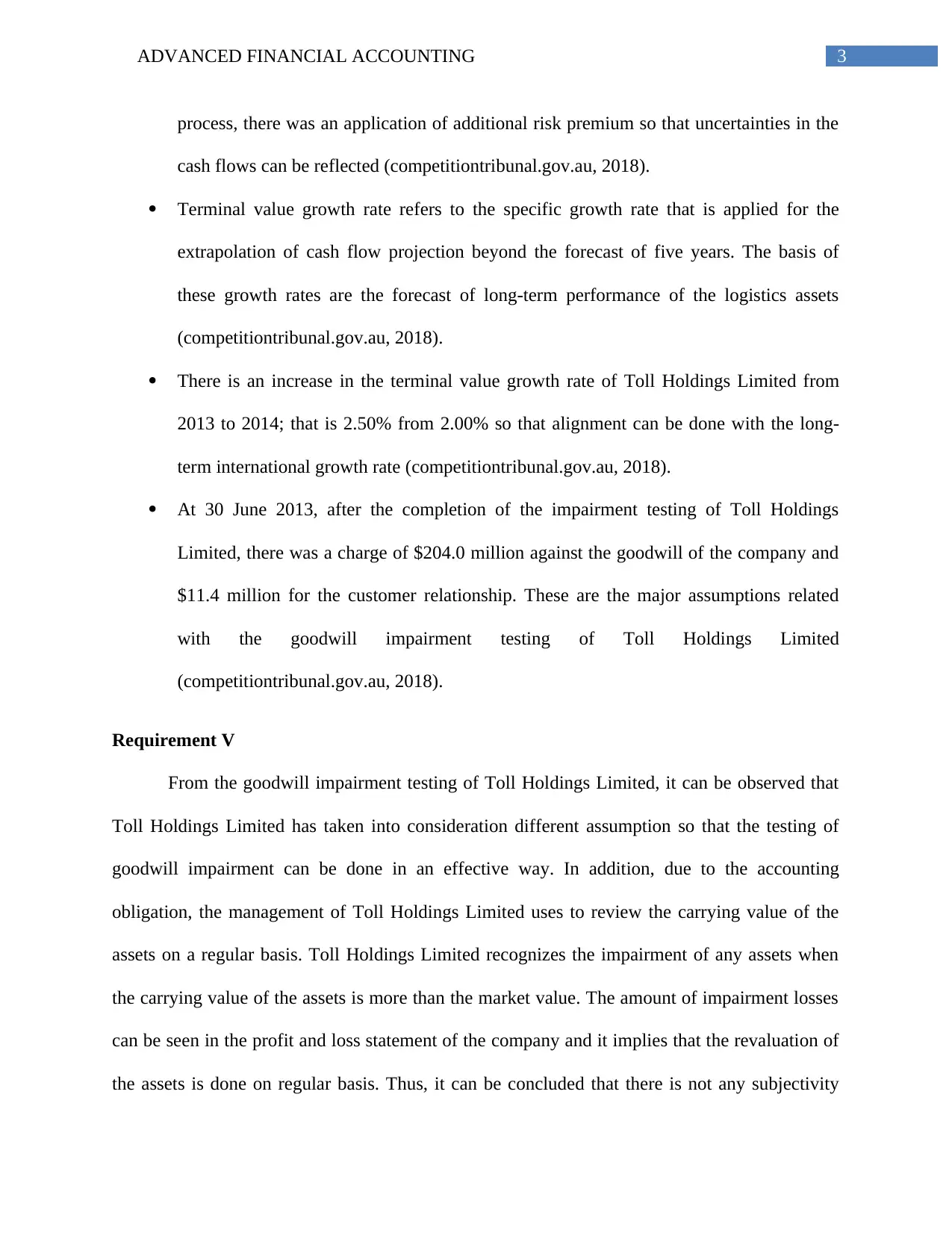
3ADVANCED FINANCIAL ACCOUNTING
process, there was an application of additional risk premium so that uncertainties in the
cash flows can be reflected (competitiontribunal.gov.au, 2018).
Terminal value growth rate refers to the specific growth rate that is applied for the
extrapolation of cash flow projection beyond the forecast of five years. The basis of
these growth rates are the forecast of long-term performance of the logistics assets
(competitiontribunal.gov.au, 2018).
There is an increase in the terminal value growth rate of Toll Holdings Limited from
2013 to 2014; that is 2.50% from 2.00% so that alignment can be done with the long-
term international growth rate (competitiontribunal.gov.au, 2018).
At 30 June 2013, after the completion of the impairment testing of Toll Holdings
Limited, there was a charge of $204.0 million against the goodwill of the company and
$11.4 million for the customer relationship. These are the major assumptions related
with the goodwill impairment testing of Toll Holdings Limited
(competitiontribunal.gov.au, 2018).
Requirement V
From the goodwill impairment testing of Toll Holdings Limited, it can be observed that
Toll Holdings Limited has taken into consideration different assumption so that the testing of
goodwill impairment can be done in an effective way. In addition, due to the accounting
obligation, the management of Toll Holdings Limited uses to review the carrying value of the
assets on a regular basis. Toll Holdings Limited recognizes the impairment of any assets when
the carrying value of the assets is more than the market value. The amount of impairment losses
can be seen in the profit and loss statement of the company and it implies that the revaluation of
the assets is done on regular basis. Thus, it can be concluded that there is not any subjectivity
process, there was an application of additional risk premium so that uncertainties in the
cash flows can be reflected (competitiontribunal.gov.au, 2018).
Terminal value growth rate refers to the specific growth rate that is applied for the
extrapolation of cash flow projection beyond the forecast of five years. The basis of
these growth rates are the forecast of long-term performance of the logistics assets
(competitiontribunal.gov.au, 2018).
There is an increase in the terminal value growth rate of Toll Holdings Limited from
2013 to 2014; that is 2.50% from 2.00% so that alignment can be done with the long-
term international growth rate (competitiontribunal.gov.au, 2018).
At 30 June 2013, after the completion of the impairment testing of Toll Holdings
Limited, there was a charge of $204.0 million against the goodwill of the company and
$11.4 million for the customer relationship. These are the major assumptions related
with the goodwill impairment testing of Toll Holdings Limited
(competitiontribunal.gov.au, 2018).
Requirement V
From the goodwill impairment testing of Toll Holdings Limited, it can be observed that
Toll Holdings Limited has taken into consideration different assumption so that the testing of
goodwill impairment can be done in an effective way. In addition, due to the accounting
obligation, the management of Toll Holdings Limited uses to review the carrying value of the
assets on a regular basis. Toll Holdings Limited recognizes the impairment of any assets when
the carrying value of the assets is more than the market value. The amount of impairment losses
can be seen in the profit and loss statement of the company and it implies that the revaluation of
the assets is done on regular basis. Thus, it can be concluded that there is not any subjectivity
Paraphrase This Document
Need a fresh take? Get an instant paraphrase of this document with our AI Paraphraser
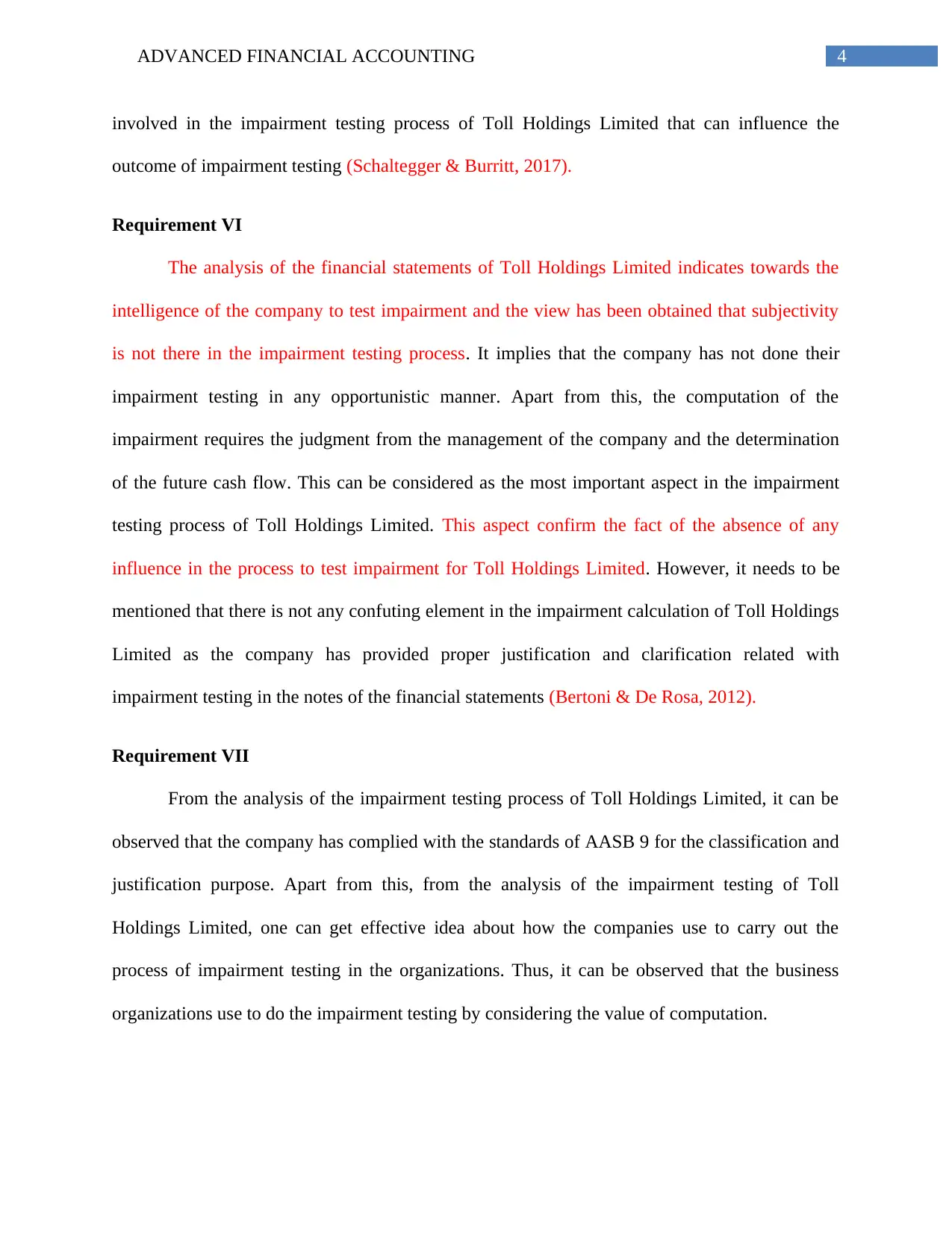
4ADVANCED FINANCIAL ACCOUNTING
involved in the impairment testing process of Toll Holdings Limited that can influence the
outcome of impairment testing (Schaltegger & Burritt, 2017).
Requirement VI
The analysis of the financial statements of Toll Holdings Limited indicates towards the
intelligence of the company to test impairment and the view has been obtained that subjectivity
is not there in the impairment testing process. It implies that the company has not done their
impairment testing in any opportunistic manner. Apart from this, the computation of the
impairment requires the judgment from the management of the company and the determination
of the future cash flow. This can be considered as the most important aspect in the impairment
testing process of Toll Holdings Limited. This aspect confirm the fact of the absence of any
influence in the process to test impairment for Toll Holdings Limited. However, it needs to be
mentioned that there is not any confuting element in the impairment calculation of Toll Holdings
Limited as the company has provided proper justification and clarification related with
impairment testing in the notes of the financial statements (Bertoni & De Rosa, 2012).
Requirement VII
From the analysis of the impairment testing process of Toll Holdings Limited, it can be
observed that the company has complied with the standards of AASB 9 for the classification and
justification purpose. Apart from this, from the analysis of the impairment testing of Toll
Holdings Limited, one can get effective idea about how the companies use to carry out the
process of impairment testing in the organizations. Thus, it can be observed that the business
organizations use to do the impairment testing by considering the value of computation.
involved in the impairment testing process of Toll Holdings Limited that can influence the
outcome of impairment testing (Schaltegger & Burritt, 2017).
Requirement VI
The analysis of the financial statements of Toll Holdings Limited indicates towards the
intelligence of the company to test impairment and the view has been obtained that subjectivity
is not there in the impairment testing process. It implies that the company has not done their
impairment testing in any opportunistic manner. Apart from this, the computation of the
impairment requires the judgment from the management of the company and the determination
of the future cash flow. This can be considered as the most important aspect in the impairment
testing process of Toll Holdings Limited. This aspect confirm the fact of the absence of any
influence in the process to test impairment for Toll Holdings Limited. However, it needs to be
mentioned that there is not any confuting element in the impairment calculation of Toll Holdings
Limited as the company has provided proper justification and clarification related with
impairment testing in the notes of the financial statements (Bertoni & De Rosa, 2012).
Requirement VII
From the analysis of the impairment testing process of Toll Holdings Limited, it can be
observed that the company has complied with the standards of AASB 9 for the classification and
justification purpose. Apart from this, from the analysis of the impairment testing of Toll
Holdings Limited, one can get effective idea about how the companies use to carry out the
process of impairment testing in the organizations. Thus, it can be observed that the business
organizations use to do the impairment testing by considering the value of computation.
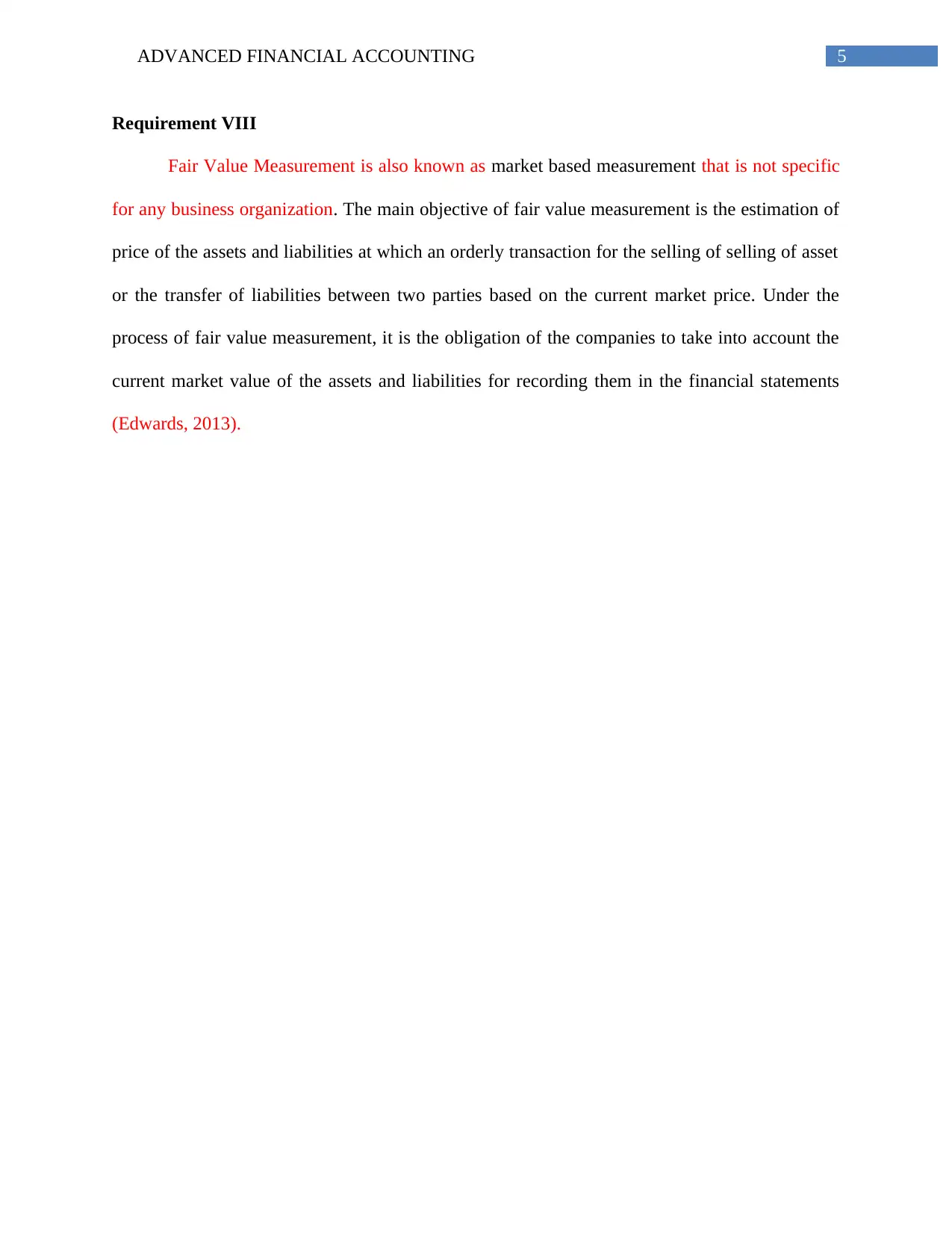
5ADVANCED FINANCIAL ACCOUNTING
Requirement VIII
Fair Value Measurement is also known as market based measurement that is not specific
for any business organization. The main objective of fair value measurement is the estimation of
price of the assets and liabilities at which an orderly transaction for the selling of selling of asset
or the transfer of liabilities between two parties based on the current market price. Under the
process of fair value measurement, it is the obligation of the companies to take into account the
current market value of the assets and liabilities for recording them in the financial statements
(Edwards, 2013).
Requirement VIII
Fair Value Measurement is also known as market based measurement that is not specific
for any business organization. The main objective of fair value measurement is the estimation of
price of the assets and liabilities at which an orderly transaction for the selling of selling of asset
or the transfer of liabilities between two parties based on the current market price. Under the
process of fair value measurement, it is the obligation of the companies to take into account the
current market value of the assets and liabilities for recording them in the financial statements
(Edwards, 2013).
⊘ This is a preview!⊘
Do you want full access?
Subscribe today to unlock all pages.

Trusted by 1+ million students worldwide
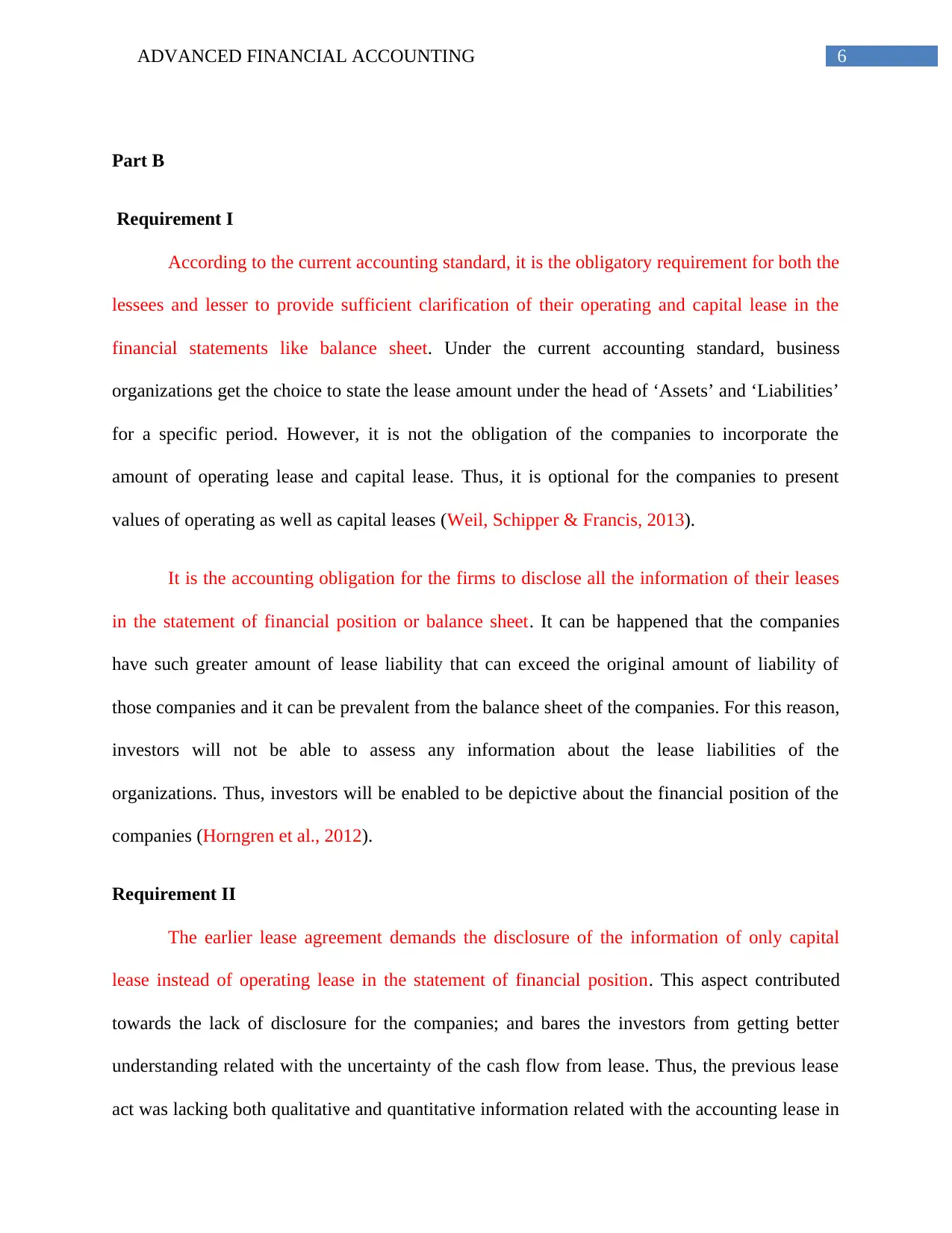
6ADVANCED FINANCIAL ACCOUNTING
Part B
Requirement I
According to the current accounting standard, it is the obligatory requirement for both the
lessees and lesser to provide sufficient clarification of their operating and capital lease in the
financial statements like balance sheet. Under the current accounting standard, business
organizations get the choice to state the lease amount under the head of ‘Assets’ and ‘Liabilities’
for a specific period. However, it is not the obligation of the companies to incorporate the
amount of operating lease and capital lease. Thus, it is optional for the companies to present
values of operating as well as capital leases (Weil, Schipper & Francis, 2013).
It is the accounting obligation for the firms to disclose all the information of their leases
in the statement of financial position or balance sheet. It can be happened that the companies
have such greater amount of lease liability that can exceed the original amount of liability of
those companies and it can be prevalent from the balance sheet of the companies. For this reason,
investors will not be able to assess any information about the lease liabilities of the
organizations. Thus, investors will be enabled to be depictive about the financial position of the
companies (Horngren et al., 2012).
Requirement II
The earlier lease agreement demands the disclosure of the information of only capital
lease instead of operating lease in the statement of financial position. This aspect contributed
towards the lack of disclosure for the companies; and bares the investors from getting better
understanding related with the uncertainty of the cash flow from lease. Thus, the previous lease
act was lacking both qualitative and quantitative information related with the accounting lease in
Part B
Requirement I
According to the current accounting standard, it is the obligatory requirement for both the
lessees and lesser to provide sufficient clarification of their operating and capital lease in the
financial statements like balance sheet. Under the current accounting standard, business
organizations get the choice to state the lease amount under the head of ‘Assets’ and ‘Liabilities’
for a specific period. However, it is not the obligation of the companies to incorporate the
amount of operating lease and capital lease. Thus, it is optional for the companies to present
values of operating as well as capital leases (Weil, Schipper & Francis, 2013).
It is the accounting obligation for the firms to disclose all the information of their leases
in the statement of financial position or balance sheet. It can be happened that the companies
have such greater amount of lease liability that can exceed the original amount of liability of
those companies and it can be prevalent from the balance sheet of the companies. For this reason,
investors will not be able to assess any information about the lease liabilities of the
organizations. Thus, investors will be enabled to be depictive about the financial position of the
companies (Horngren et al., 2012).
Requirement II
The earlier lease agreement demands the disclosure of the information of only capital
lease instead of operating lease in the statement of financial position. This aspect contributed
towards the lack of disclosure for the companies; and bares the investors from getting better
understanding related with the uncertainty of the cash flow from lease. Thus, the previous lease
act was lacking both qualitative and quantitative information related with the accounting lease in
Paraphrase This Document
Need a fresh take? Get an instant paraphrase of this document with our AI Paraphraser
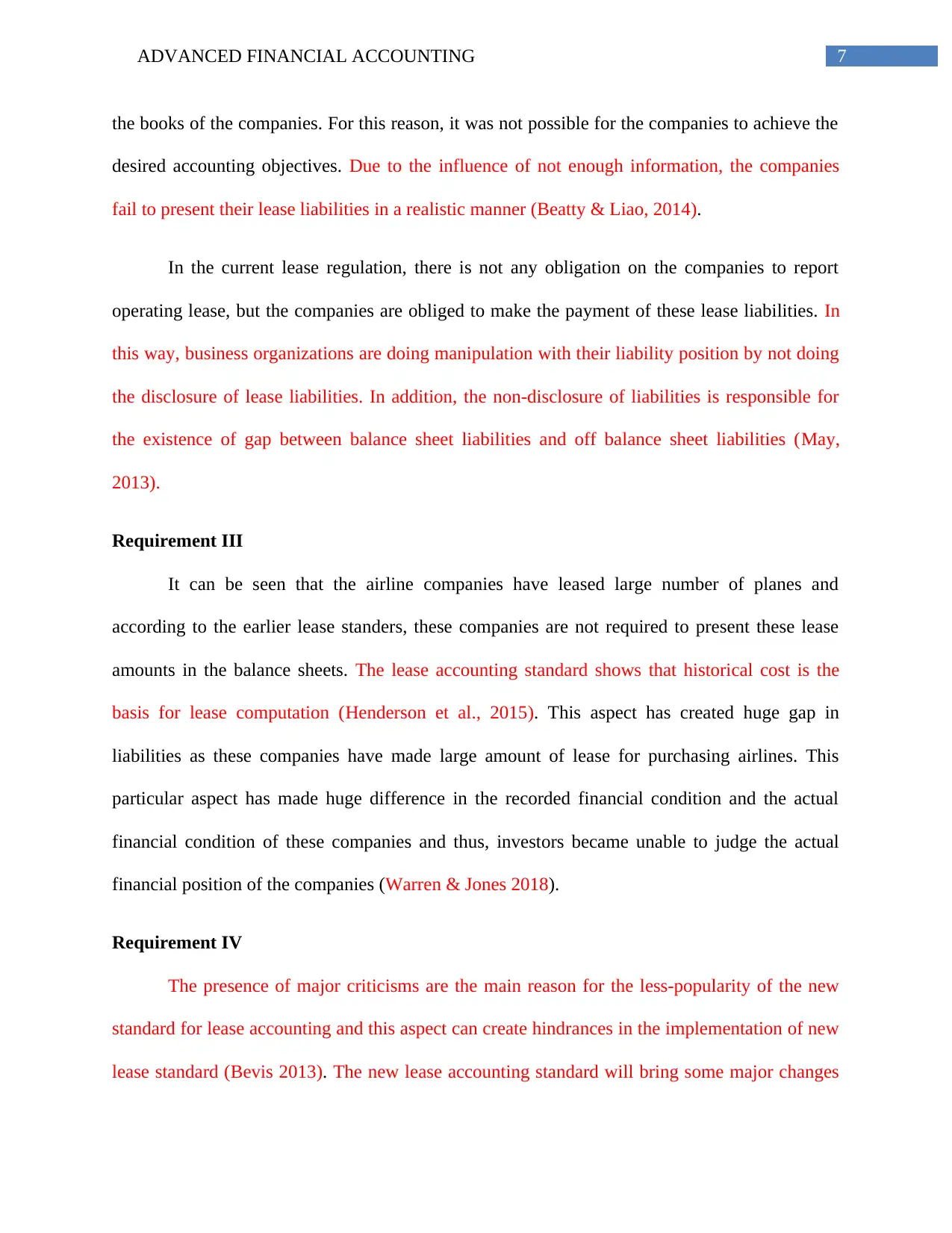
7ADVANCED FINANCIAL ACCOUNTING
the books of the companies. For this reason, it was not possible for the companies to achieve the
desired accounting objectives. Due to the influence of not enough information, the companies
fail to present their lease liabilities in a realistic manner (Beatty & Liao, 2014).
In the current lease regulation, there is not any obligation on the companies to report
operating lease, but the companies are obliged to make the payment of these lease liabilities. In
this way, business organizations are doing manipulation with their liability position by not doing
the disclosure of lease liabilities. In addition, the non-disclosure of liabilities is responsible for
the existence of gap between balance sheet liabilities and off balance sheet liabilities (May,
2013).
Requirement III
It can be seen that the airline companies have leased large number of planes and
according to the earlier lease standers, these companies are not required to present these lease
amounts in the balance sheets. The lease accounting standard shows that historical cost is the
basis for lease computation (Henderson et al., 2015). This aspect has created huge gap in
liabilities as these companies have made large amount of lease for purchasing airlines. This
particular aspect has made huge difference in the recorded financial condition and the actual
financial condition of these companies and thus, investors became unable to judge the actual
financial position of the companies (Warren & Jones 2018).
Requirement IV
The presence of major criticisms are the main reason for the less-popularity of the new
standard for lease accounting and this aspect can create hindrances in the implementation of new
lease standard (Bevis 2013). The new lease accounting standard will bring some major changes
the books of the companies. For this reason, it was not possible for the companies to achieve the
desired accounting objectives. Due to the influence of not enough information, the companies
fail to present their lease liabilities in a realistic manner (Beatty & Liao, 2014).
In the current lease regulation, there is not any obligation on the companies to report
operating lease, but the companies are obliged to make the payment of these lease liabilities. In
this way, business organizations are doing manipulation with their liability position by not doing
the disclosure of lease liabilities. In addition, the non-disclosure of liabilities is responsible for
the existence of gap between balance sheet liabilities and off balance sheet liabilities (May,
2013).
Requirement III
It can be seen that the airline companies have leased large number of planes and
according to the earlier lease standers, these companies are not required to present these lease
amounts in the balance sheets. The lease accounting standard shows that historical cost is the
basis for lease computation (Henderson et al., 2015). This aspect has created huge gap in
liabilities as these companies have made large amount of lease for purchasing airlines. This
particular aspect has made huge difference in the recorded financial condition and the actual
financial condition of these companies and thus, investors became unable to judge the actual
financial position of the companies (Warren & Jones 2018).
Requirement IV
The presence of major criticisms are the main reason for the less-popularity of the new
standard for lease accounting and this aspect can create hindrances in the implementation of new
lease standard (Bevis 2013). The new lease accounting standard will bring some major changes
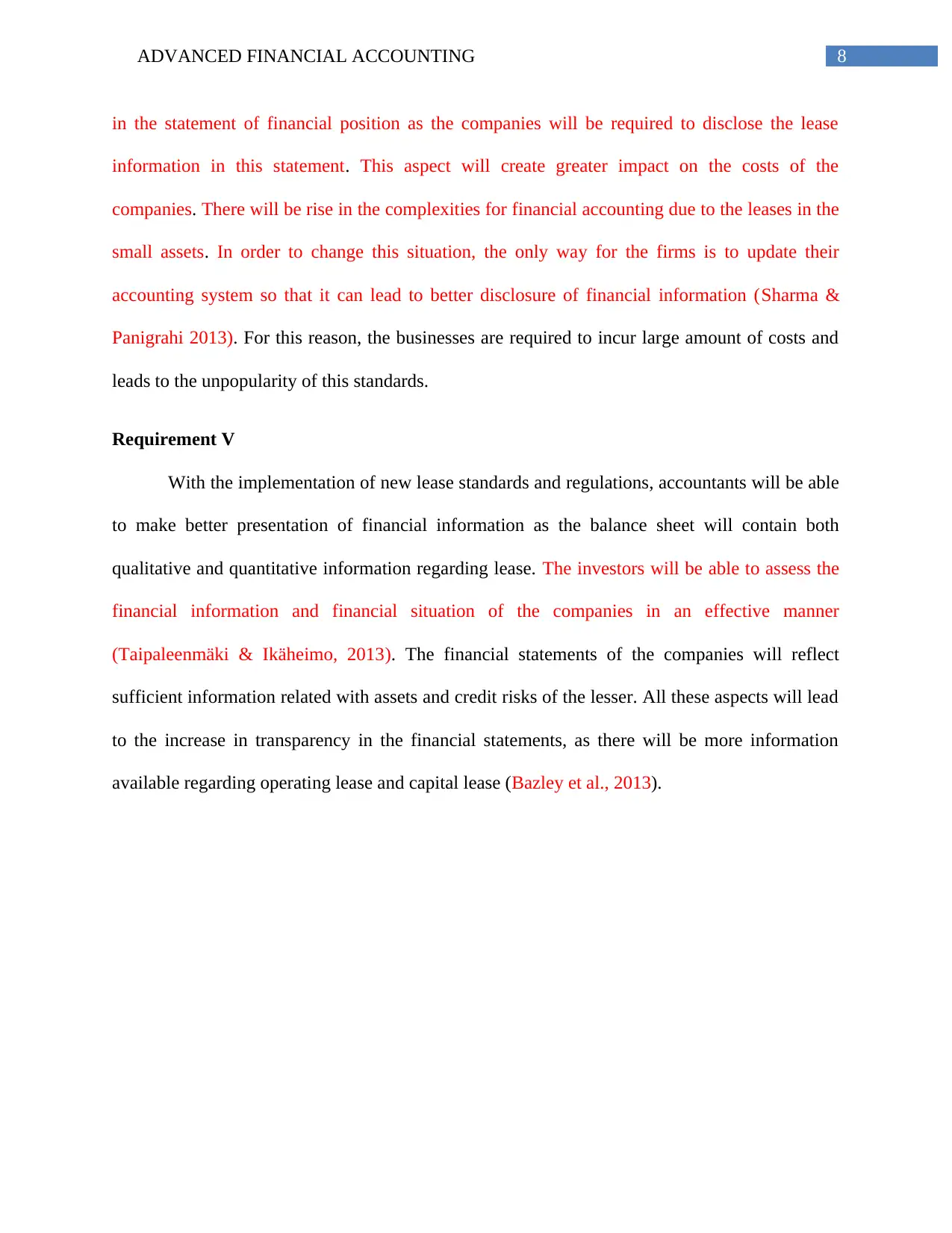
8ADVANCED FINANCIAL ACCOUNTING
in the statement of financial position as the companies will be required to disclose the lease
information in this statement. This aspect will create greater impact on the costs of the
companies. There will be rise in the complexities for financial accounting due to the leases in the
small assets. In order to change this situation, the only way for the firms is to update their
accounting system so that it can lead to better disclosure of financial information (Sharma &
Panigrahi 2013). For this reason, the businesses are required to incur large amount of costs and
leads to the unpopularity of this standards.
Requirement V
With the implementation of new lease standards and regulations, accountants will be able
to make better presentation of financial information as the balance sheet will contain both
qualitative and quantitative information regarding lease. The investors will be able to assess the
financial information and financial situation of the companies in an effective manner
(Taipaleenmäki & Ikäheimo, 2013). The financial statements of the companies will reflect
sufficient information related with assets and credit risks of the lesser. All these aspects will lead
to the increase in transparency in the financial statements, as there will be more information
available regarding operating lease and capital lease (Bazley et al., 2013).
in the statement of financial position as the companies will be required to disclose the lease
information in this statement. This aspect will create greater impact on the costs of the
companies. There will be rise in the complexities for financial accounting due to the leases in the
small assets. In order to change this situation, the only way for the firms is to update their
accounting system so that it can lead to better disclosure of financial information (Sharma &
Panigrahi 2013). For this reason, the businesses are required to incur large amount of costs and
leads to the unpopularity of this standards.
Requirement V
With the implementation of new lease standards and regulations, accountants will be able
to make better presentation of financial information as the balance sheet will contain both
qualitative and quantitative information regarding lease. The investors will be able to assess the
financial information and financial situation of the companies in an effective manner
(Taipaleenmäki & Ikäheimo, 2013). The financial statements of the companies will reflect
sufficient information related with assets and credit risks of the lesser. All these aspects will lead
to the increase in transparency in the financial statements, as there will be more information
available regarding operating lease and capital lease (Bazley et al., 2013).
⊘ This is a preview!⊘
Do you want full access?
Subscribe today to unlock all pages.

Trusted by 1+ million students worldwide
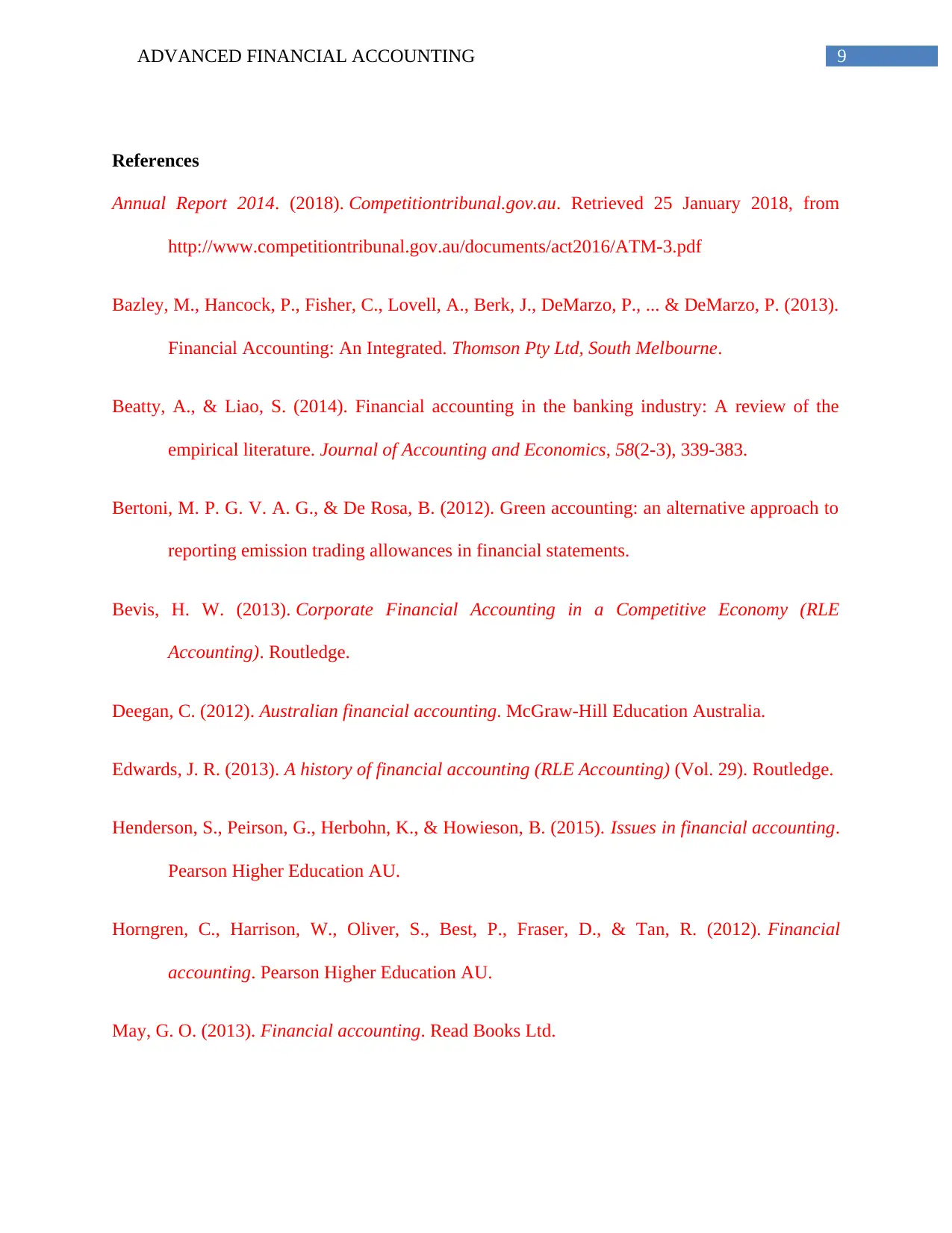
9ADVANCED FINANCIAL ACCOUNTING
References
Annual Report 2014. (2018). Competitiontribunal.gov.au. Retrieved 25 January 2018, from
http://www.competitiontribunal.gov.au/documents/act2016/ATM-3.pdf
Bazley, M., Hancock, P., Fisher, C., Lovell, A., Berk, J., DeMarzo, P., ... & DeMarzo, P. (2013).
Financial Accounting: An Integrated. Thomson Pty Ltd, South Melbourne.
Beatty, A., & Liao, S. (2014). Financial accounting in the banking industry: A review of the
empirical literature. Journal of Accounting and Economics, 58(2-3), 339-383.
Bertoni, M. P. G. V. A. G., & De Rosa, B. (2012). Green accounting: an alternative approach to
reporting emission trading allowances in financial statements.
Bevis, H. W. (2013). Corporate Financial Accounting in a Competitive Economy (RLE
Accounting). Routledge.
Deegan, C. (2012). Australian financial accounting. McGraw-Hill Education Australia.
Edwards, J. R. (2013). A history of financial accounting (RLE Accounting) (Vol. 29). Routledge.
Henderson, S., Peirson, G., Herbohn, K., & Howieson, B. (2015). Issues in financial accounting.
Pearson Higher Education AU.
Horngren, C., Harrison, W., Oliver, S., Best, P., Fraser, D., & Tan, R. (2012). Financial
accounting. Pearson Higher Education AU.
May, G. O. (2013). Financial accounting. Read Books Ltd.
References
Annual Report 2014. (2018). Competitiontribunal.gov.au. Retrieved 25 January 2018, from
http://www.competitiontribunal.gov.au/documents/act2016/ATM-3.pdf
Bazley, M., Hancock, P., Fisher, C., Lovell, A., Berk, J., DeMarzo, P., ... & DeMarzo, P. (2013).
Financial Accounting: An Integrated. Thomson Pty Ltd, South Melbourne.
Beatty, A., & Liao, S. (2014). Financial accounting in the banking industry: A review of the
empirical literature. Journal of Accounting and Economics, 58(2-3), 339-383.
Bertoni, M. P. G. V. A. G., & De Rosa, B. (2012). Green accounting: an alternative approach to
reporting emission trading allowances in financial statements.
Bevis, H. W. (2013). Corporate Financial Accounting in a Competitive Economy (RLE
Accounting). Routledge.
Deegan, C. (2012). Australian financial accounting. McGraw-Hill Education Australia.
Edwards, J. R. (2013). A history of financial accounting (RLE Accounting) (Vol. 29). Routledge.
Henderson, S., Peirson, G., Herbohn, K., & Howieson, B. (2015). Issues in financial accounting.
Pearson Higher Education AU.
Horngren, C., Harrison, W., Oliver, S., Best, P., Fraser, D., & Tan, R. (2012). Financial
accounting. Pearson Higher Education AU.
May, G. O. (2013). Financial accounting. Read Books Ltd.
Paraphrase This Document
Need a fresh take? Get an instant paraphrase of this document with our AI Paraphraser
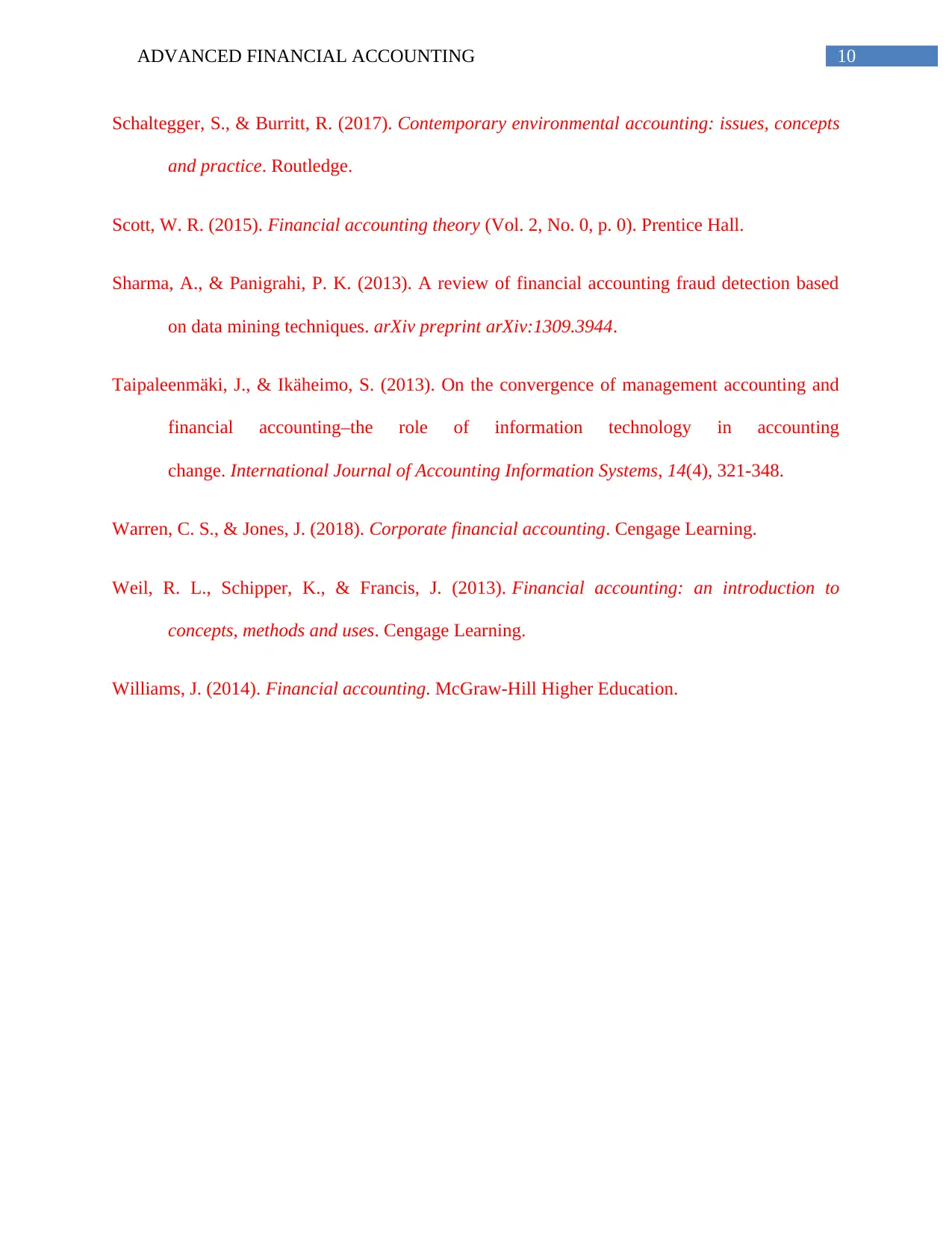
10ADVANCED FINANCIAL ACCOUNTING
Schaltegger, S., & Burritt, R. (2017). Contemporary environmental accounting: issues, concepts
and practice. Routledge.
Scott, W. R. (2015). Financial accounting theory (Vol. 2, No. 0, p. 0). Prentice Hall.
Sharma, A., & Panigrahi, P. K. (2013). A review of financial accounting fraud detection based
on data mining techniques. arXiv preprint arXiv:1309.3944.
Taipaleenmäki, J., & Ikäheimo, S. (2013). On the convergence of management accounting and
financial accounting–the role of information technology in accounting
change. International Journal of Accounting Information Systems, 14(4), 321-348.
Warren, C. S., & Jones, J. (2018). Corporate financial accounting. Cengage Learning.
Weil, R. L., Schipper, K., & Francis, J. (2013). Financial accounting: an introduction to
concepts, methods and uses. Cengage Learning.
Williams, J. (2014). Financial accounting. McGraw-Hill Higher Education.
Schaltegger, S., & Burritt, R. (2017). Contemporary environmental accounting: issues, concepts
and practice. Routledge.
Scott, W. R. (2015). Financial accounting theory (Vol. 2, No. 0, p. 0). Prentice Hall.
Sharma, A., & Panigrahi, P. K. (2013). A review of financial accounting fraud detection based
on data mining techniques. arXiv preprint arXiv:1309.3944.
Taipaleenmäki, J., & Ikäheimo, S. (2013). On the convergence of management accounting and
financial accounting–the role of information technology in accounting
change. International Journal of Accounting Information Systems, 14(4), 321-348.
Warren, C. S., & Jones, J. (2018). Corporate financial accounting. Cengage Learning.
Weil, R. L., Schipper, K., & Francis, J. (2013). Financial accounting: an introduction to
concepts, methods and uses. Cengage Learning.
Williams, J. (2014). Financial accounting. McGraw-Hill Higher Education.
1 out of 11
Related Documents
Your All-in-One AI-Powered Toolkit for Academic Success.
+13062052269
info@desklib.com
Available 24*7 on WhatsApp / Email
![[object Object]](/_next/static/media/star-bottom.7253800d.svg)
Unlock your academic potential
Copyright © 2020–2025 A2Z Services. All Rights Reserved. Developed and managed by ZUCOL.





